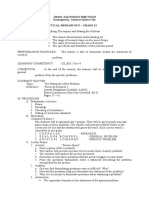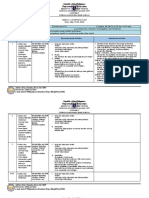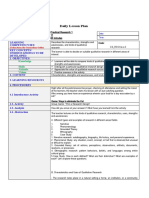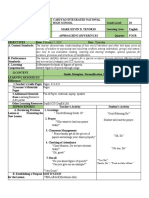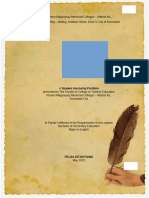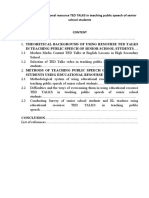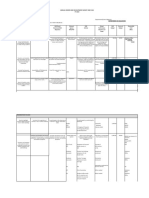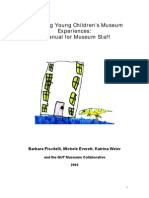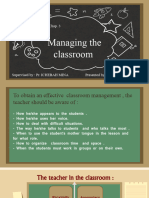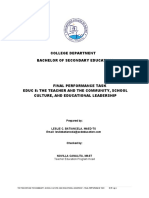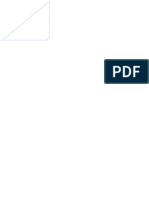Daily Lesson LOG
Daily Lesson LOG
Uploaded by
Leah CrisostomoCopyright:
Available Formats
Daily Lesson LOG
Daily Lesson LOG
Uploaded by
Leah CrisostomoOriginal Description:
Original Title
Copyright
Available Formats
Share this document
Did you find this document useful?
Is this content inappropriate?
Copyright:
Available Formats
Daily Lesson LOG
Daily Lesson LOG
Uploaded by
Leah CrisostomoCopyright:
Available Formats
School DON BOSCO NATIONAL Grade Level GRADE 12
DAILY HIGH SCHOOL
LESSON Teacher PRISCILA J. CELORIO Learning Area Inquiries, Investigation,
LOG and Immersion
Teaching Dates April 3, 2023 Quarter Third
and Time 09:00 – 10:00 AM
SESSION 1
I. Objectives
A. Content Standards The students demonstrate an understanding of the:
Understanding Ways to Collect Data.
C. Learning Competencies The students should be able to
D. Specific Learning Objectives At the end of the lesson, the students are expected to:
1. Differentiate the three research designs according to purpose and
procedure.
2. Distinguish the research design used in a quantitative research.
3. Assess the quality of a specific research design used in a
quantitative research study.
4. Develop the value of being organized in presenting research.
II. Content Understanding Ways to Collect Data in Quantitative Research
III. Learning Resources
A. References
1. Teacher’s Guide Inquiries, Investigation, and Immersion (2020 Edition)
2. Learner’s Materials pages Module 4, Lesson 1 Inquiries, Investigation, and Immersion
3. Textbook Pages Inquiries, Investigation, and Immersion (2020 Edition)
B. Other Learning Resources
IV. Procedures
A. Reviewing the previous lesson Routinary Activities:
or presenting the new lesson 1. Prayer
2. Attendance and assignment checking by Class Secretary
3. Classroom etiquette
ELICIT
ACTIVITY: MY VOCABULARY LIST
- Teacher will slowly elicit words related to acronym R-E-S-E-A-R-C-H.
- Learners will list down words beginning each letter of RESEARCH
-Learners will discuss how these words are related to research .
- Identify the types of research on the sample research topics.
B. Establishing a purpose for the ENGAGE
lesson 1. Ask the question to the learners “How do you want your data to be
measured and collected?
2. Teacher will post a sample situation to be analyzed by the learners
C. Presenting examples/ EXPLORE
instances of the new lesson 1. Discuss the Quantitative Research Designs
D. Discussing new concepts and - Experimental Research
practicing new skills - Descriptive Research
- Correlational Research
2. Examples of research topics will be explored identifying each kinds of
research designs.
INTEGRATIONS
Across and within the Curriculum
English – Expanding Vocabulary and Proper Pronunciations
Science – Experiment
E. Developing mastery leads to EXPLAIN
formative assessment 1. Teacher will discuss the kinds of quantitative research design.
2. Learners will do the activity during the discussion.
-Identify the independent and dependent variables
- Analysis of the situation on what kinds of research design is being
employed.
- Determine the research design most appropriate for the given research
problems.
F. Finding practical applications ELABORATE
of concepts and skills in daily GROUP ACTIVITY: This activity will serve as their performance task.
living Evaluation of Research
F. Making generalizations and ELABORATE
abstractions about the lesson - The students will answer the following questions:
1. What are the factors to consider in using quantitative research design?
2.In what part of research can research design be easily identified ?
G. Evaluating Learning 3. What are the kinds of quantitative research ?
EVALUATE
-The learners will determine the research design appropriate for the given
research problems
- The learners will meet their group on their research project and work on the
research designs appropriate for their currently working research topic.
H. Additional Activities for EXTEND
application of remediation Learners will do this activity at home.
1. Look for five journal articles related to your research.
2. Identify if the research design used was descriptive, experimental, or
correlational.
3. Explain briefly why the research design is appropriate for the study.
V. Remarks
VI. Reflection
Prepared by:
Priscila J. Celorio
Teacher II/ Subject Teacher
Checked by:
EDUARDO M. TAGUIAM, PhD.
School Principal II
You might also like
- lESSON PLAN 3is 6Document7 pageslESSON PLAN 3is 6Aiza AbantoNo ratings yet
- Johnny Ang National High School Katangawan, General Santos City Lesson Plan in Practical Research Ii - Grade 12Document3 pagesJohnny Ang National High School Katangawan, General Santos City Lesson Plan in Practical Research Ii - Grade 12Aljon Domingo Tabuada100% (1)
- I. Objectives: Joan A. RiparipDocument3 pagesI. Objectives: Joan A. RiparipJoan RiparipNo ratings yet
- Ballroom and Latin Dance Studio - Business PlanDocument24 pagesBallroom and Latin Dance Studio - Business PlanmasroorNo ratings yet
- Iii Q3 Week 5 DLLDocument3 pagesIii Q3 Week 5 DLLFatima DuncabNo ratings yet
- Iii Q3 Week 3 DLLDocument3 pagesIii Q3 Week 3 DLLFatima DuncabNo ratings yet
- Capstone w1 q3Document7 pagesCapstone w1 q3Erica RiveraNo ratings yet
- DLP For Inquiries Investigations and ImmersionDocument5 pagesDLP For Inquiries Investigations and ImmersionLeizel Jane LjNo ratings yet
- Inquiries, Investigations, and ImmersionsDocument9 pagesInquiries, Investigations, and ImmersionsJESSECA MULLETNo ratings yet
- Preparatory Activities:: Inquiries, Investigation & Immersion SEPTEMBER 25, 2019Document4 pagesPreparatory Activities:: Inquiries, Investigation & Immersion SEPTEMBER 25, 2019Maria Salvacion TunayaNo ratings yet
- COT 1 LP Presents Written Statement of The ProblemDocument6 pagesCOT 1 LP Presents Written Statement of The ProblemRufil Flores OdioNo ratings yet
- Iii Q3 Week 2 DLLDocument3 pagesIii Q3 Week 2 DLLFatima Duncab100% (1)
- Iii Q3 Week 4 DLLDocument3 pagesIii Q3 Week 4 DLLFatima DuncabNo ratings yet
- Identifying Problem and Asking QuestionsDocument23 pagesIdentifying Problem and Asking QuestionsMelvin H. MadroñalNo ratings yet
- 3Is-WLP-Q4-Weeks 2-7Document6 pages3Is-WLP-Q4-Weeks 2-7Maria Lourdes PunayNo ratings yet
- PR LP Week1Document17 pagesPR LP Week1sucel rojoNo ratings yet
- Lesson Plan in Practical Research 2: (Quantitative Research For SHS) - Manila: Lorimar Publishing, IncDocument2 pagesLesson Plan in Practical Research 2: (Quantitative Research For SHS) - Manila: Lorimar Publishing, IncJan Quinicio100% (1)
- DLP Research 2 Week 1 PDFDocument4 pagesDLP Research 2 Week 1 PDFManalang, Mark Joseph G.No ratings yet
- Elsa Detailed Lesson Plan in ResearchDocument6 pagesElsa Detailed Lesson Plan in ResearchElsa Quiros TerreNo ratings yet
- Q4 Week 3 INQUIRIES, INVESTIGATIONS, IMMERSIONDocument9 pagesQ4 Week 3 INQUIRIES, INVESTIGATIONS, IMMERSIONPricess LingadNo ratings yet
- STEM PR2 Osorio Week-5-6Document19 pagesSTEM PR2 Osorio Week-5-6ganda dyosaNo ratings yet
- 2022-2023 PR1 DLL Week 8Document2 pages2022-2023 PR1 DLL Week 8Anne Cris AzorNo ratings yet
- DLL Cot Demo PR1Document3 pagesDLL Cot Demo PR1CHRISTOPHER A. CRUZNo ratings yet
- Id Brainstorming-Good-Topics-For-Research-Papers: Present Me The Research!Document2 pagesId Brainstorming-Good-Topics-For-Research-Papers: Present Me The Research!JOEMAR JAVIERNo ratings yet
- PR 1 DLPDocument3 pagesPR 1 DLPRubenNo ratings yet
- CO - Practical Research 1 (Detailed Lesson Plan)Document8 pagesCO - Practical Research 1 (Detailed Lesson Plan)L.G. Maquirang100% (1)
- Cs - rs1 DLL June 25-29, 2018 Grade 12Document4 pagesCs - rs1 DLL June 25-29, 2018 Grade 12Judame Charo ZozobradoNo ratings yet
- DLP PR1 - 9Document6 pagesDLP PR1 - 9Cyril DofelizNo ratings yet
- III Q3 Week 3 RevisedDocument10 pagesIII Q3 Week 3 RevisedRona Grace MartinezNo ratings yet
- Daily Lesson Plan: Learning Area: Practical Research 1 Grade Level: 11 Duration: 60 MinutesDocument2 pagesDaily Lesson Plan: Learning Area: Practical Research 1 Grade Level: 11 Duration: 60 MinutesCyril DofelizNo ratings yet
- Department of Education: Republic of The PhilippinesDocument3 pagesDepartment of Education: Republic of The PhilippinesAdonis BesaNo ratings yet
- DLP-Practical Resaerch 1-COT-qualitativeDocument5 pagesDLP-Practical Resaerch 1-COT-qualitativeMary Neol HijaponNo ratings yet
- Content Area Item Specification (Type of Test and Placement)Document1 pageContent Area Item Specification (Type of Test and Placement)Sha Sadangsal100% (1)
- RANKING Practical Research SEmi Detailed Lesson PlanDocument3 pagesRANKING Practical Research SEmi Detailed Lesson PlanREYNNo ratings yet
- VII - Sharing Your ResearchDocument1 pageVII - Sharing Your ResearchJesseca Jean Aguilar SepilloNo ratings yet
- Summative Test in Inquiries Weeks 1,2, 3,4Document5 pagesSummative Test in Inquiries Weeks 1,2, 3,4Rafael Luis MuyanoNo ratings yet
- Present Written Statement of The Problem: (CS - RS12-Id-e-7)Document1 pagePresent Written Statement of The Problem: (CS - RS12-Id-e-7)Angelo Villafranca0% (1)
- DLL 2nd Sem - Research 1 - WK 2 - Nov 21-25 - Purpose of Research, Types & ApproachesDocument3 pagesDLL 2nd Sem - Research 1 - WK 2 - Nov 21-25 - Purpose of Research, Types & ApproachesSteffiNo ratings yet
- Characteristics, Strengths, and WeaknessesDocument30 pagesCharacteristics, Strengths, and WeaknessesErica Canon100% (1)
- Practical Research 2 DLP 28Document4 pagesPractical Research 2 DLP 28Jumps LaroaNo ratings yet
- Daily Lesson Log - Listing ReferencesDocument4 pagesDaily Lesson Log - Listing ReferencesGoogly DriveNo ratings yet
- DLP Sampling ProcedureDocument7 pagesDLP Sampling ProcedureCristel Anne A. Llamador100% (1)
- 3is QUARTER 3 WEEK2Document5 pages3is QUARTER 3 WEEK2Monique Busran100% (1)
- Lesson Plan in Practical Research 1: Republic of The Philippines Department of EducationDocument3 pagesLesson Plan in Practical Research 1: Republic of The Philippines Department of Educationmargie faustinoNo ratings yet
- Semi-Detailed Lesson Plan PR1Document11 pagesSemi-Detailed Lesson Plan PR1Maricel DiapanaNo ratings yet
- Q3 - Inquiries, Investigation, and Immersion - ReviewerDocument11 pagesQ3 - Inquiries, Investigation, and Immersion - ReviewerGlean EsmileNo ratings yet
- PRACTICAL RESEARCH 1 - TOS-Midterm-ExamDocument2 pagesPRACTICAL RESEARCH 1 - TOS-Midterm-ExamJulie Mae DayujaNo ratings yet
- Daily Lesson Plan: Learning Area: Practical Research 1 Grade Level: 11 Duration: 60 MinutesDocument2 pagesDaily Lesson Plan: Learning Area: Practical Research 1 Grade Level: 11 Duration: 60 MinutesCyril DofelizNo ratings yet
- Detailed Lesson Plan (DLP) Format: Practical Research 1Document1 pageDetailed Lesson Plan (DLP) Format: Practical Research 1Keppy Aricangoy100% (1)
- MODULE4-Designs A Research Used in Daily LifeDocument14 pagesMODULE4-Designs A Research Used in Daily LifeMira Rochenie CuranNo ratings yet
- Lesson Guide in Practical Research 1 Jan. 06, 2020: I. ObjectivesDocument8 pagesLesson Guide in Practical Research 1 Jan. 06, 2020: I. ObjectivesJulieAnnLucasBagamaspadNo ratings yet
- DLL 3is Week 2Document4 pagesDLL 3is Week 2Jesamie Bactol Seriño100% (1)
- Qualitative Research and Its Importance in Daily Life: Cs - Rs11-Iiib-1 Describes Characteristics, StrengthsDocument7 pagesQualitative Research and Its Importance in Daily Life: Cs - Rs11-Iiib-1 Describes Characteristics, StrengthsNazarene MadapinNo ratings yet
- Grade 12 Inquiries, Investigation and Immersion DLLDocument2 pagesGrade 12 Inquiries, Investigation and Immersion DLLCatherine AliviaNo ratings yet
- Lesson Plan Week 2Document4 pagesLesson Plan Week 2Gian Jane QuiñonesNo ratings yet
- Practical-Research-DLL-Week 2Document3 pagesPractical-Research-DLL-Week 2JIMP ISRAEL CABUHATNo ratings yet
- Johnny Ang National High School Katangawan, General Santos City Lesson Plan in Practical Research Ii - Grade 12Document2 pagesJohnny Ang National High School Katangawan, General Santos City Lesson Plan in Practical Research Ii - Grade 12Aljon Domingo TabuadaNo ratings yet
- Inquiries, Investigation & Immersion Week 8Document13 pagesInquiries, Investigation & Immersion Week 8CRISLYN ABERGAS100% (1)
- LD III To UploadDocument2 pagesLD III To UploadGeorgia Adolfo Pahulaya OtacanNo ratings yet
- Standard Style in RRLDocument7 pagesStandard Style in RRLKaiA.SermenoNo ratings yet
- SHS W2 Quarter-3 Week 2 LP SY2022-2023Document2 pagesSHS W2 Quarter-3 Week 2 LP SY2022-2023Leah CrisostomoNo ratings yet
- SHS WI Quarter-3 Week 3 LP SY2022-2023Document2 pagesSHS WI Quarter-3 Week 3 LP SY2022-2023Leah CrisostomoNo ratings yet
- SHS WI Quarter-3 Week 1 LP SY2022-2023Document2 pagesSHS WI Quarter-3 Week 1 LP SY2022-2023Leah CrisostomoNo ratings yet
- Work Immersion Research OutputDocument40 pagesWork Immersion Research OutputLeah CrisostomoNo ratings yet
- HUMSS (UCSP) Grade11 Quarter1 Module Week6Document8 pagesHUMSS (UCSP) Grade11 Quarter1 Module Week6Leah CrisostomoNo ratings yet
- SHS WI Quarter-3 Week 6 LP SY2022-2023-1Document3 pagesSHS WI Quarter-3 Week 6 LP SY2022-2023-1Leah CrisostomoNo ratings yet
- Approaching Differences: "Yes, Sir!" Simile, Sir.", "Treat Me Like A Rose."Document3 pagesApproaching Differences: "Yes, Sir!" Simile, Sir.", "Treat Me Like A Rose."Vincent Ian TañaisNo ratings yet
- UOI Planner Early Years en PDFDocument6 pagesUOI Planner Early Years en PDFRhonaNo ratings yet
- CPA - A Guide For TeachersDocument162 pagesCPA - A Guide For TeachersXevi Camps PochNo ratings yet
- LESSON 2: The 21 Century TeacherDocument3 pagesLESSON 2: The 21 Century TeacherAlyssa Jane NarvasNo ratings yet
- Ate Fhel PortfolioDocument99 pagesAte Fhel PortfolioJOEMAR JHAN P. ORERANo ratings yet
- Learner Centered Ideology: Presented To: Sir Khalid MehmoodDocument57 pagesLearner Centered Ideology: Presented To: Sir Khalid MehmoodMuqaddas MalikNo ratings yet
- Assessment 1Document9 pagesAssessment 1api-321063684No ratings yet
- UntitledDocument29 pagesUntitledAliya BektenovaNo ratings yet
- San Antonio Es Gad Accomplishment Report 2023Document8 pagesSan Antonio Es Gad Accomplishment Report 2023Janeth LayaNo ratings yet
- All Our Futures: Creativity, Culture and EducationDocument243 pagesAll Our Futures: Creativity, Culture and EducationJoaquín Vicente Ramos RodríguezNo ratings yet
- Lesson Plan Form: III/English IIIDocument6 pagesLesson Plan Form: III/English IIIapi-439274163100% (1)
- ASSESSMENT OF SCHOOL CRITICAL SAFETY CONCERN - Zorabel Maria A. Delos ReyesDocument11 pagesASSESSMENT OF SCHOOL CRITICAL SAFETY CONCERN - Zorabel Maria A. Delos ReyesIOER International Multidisciplinary Research Journal ( IIMRJ)No ratings yet
- Personalized Learning Plan Packet For WBL Word CorrectedDocument19 pagesPersonalized Learning Plan Packet For WBL Word Correctedapi-459051066No ratings yet
- Enhancing Childrens Museum Experiences PDFDocument120 pagesEnhancing Childrens Museum Experiences PDFMahendran ChokkanathanNo ratings yet
- Đề Chuyển Cấp Tphcm 2020-2021Document4 pagesĐề Chuyển Cấp Tphcm 2020-2021Phan Xuân ThyNo ratings yet
- Applied Linguistics and TESOL PHD and MPhil Supervisors - University of LeicestDocument4 pagesApplied Linguistics and TESOL PHD and MPhil Supervisors - University of LeicestHussam RajabNo ratings yet
- Managing ClassroomDocument17 pagesManaging ClassroomnadaatakallaNo ratings yet
- Communicative Language Teaching: Changing Students' Speaking SkillDocument15 pagesCommunicative Language Teaching: Changing Students' Speaking Skillhenny sulistyawatiNo ratings yet
- Educ 8 LP7 - Final PTDocument9 pagesEduc 8 LP7 - Final PTRejine DelrosarioNo ratings yet
- DLL Reading Writing Week 1Document5 pagesDLL Reading Writing Week 1Mae PalanasNo ratings yet
- GATSBY STEM Key IndicatorsDocument16 pagesGATSBY STEM Key IndicatorsHugo CarriónNo ratings yet
- EDUC 203 001 (Rioux-Bailey) Fall 18Document10 pagesEDUC 203 001 (Rioux-Bailey) Fall 18bradNo ratings yet
- Calla Integrating Language Content and Ls in EltDocument3 pagesCalla Integrating Language Content and Ls in EltsirredsNo ratings yet
- Writing For Success 1445970582 PDFDocument600 pagesWriting For Success 1445970582 PDFashumpwcNo ratings yet
- Let Reviewer 2017Document40 pagesLet Reviewer 2017Claudene GellaNo ratings yet
- SBMDocument7 pagesSBMDai N EssNo ratings yet
- Revised Syllabus in Approaches in Teaching Social Studies 2Document11 pagesRevised Syllabus in Approaches in Teaching Social Studies 2Jay BansaleNo ratings yet
- The Professional Development of School Principals: Isaac MathibeDocument18 pagesThe Professional Development of School Principals: Isaac MathibeFrancis DecenaNo ratings yet
- No Homework at SchoolDocument8 pagesNo Homework at Schooll0f0lybonol2100% (1)

